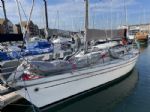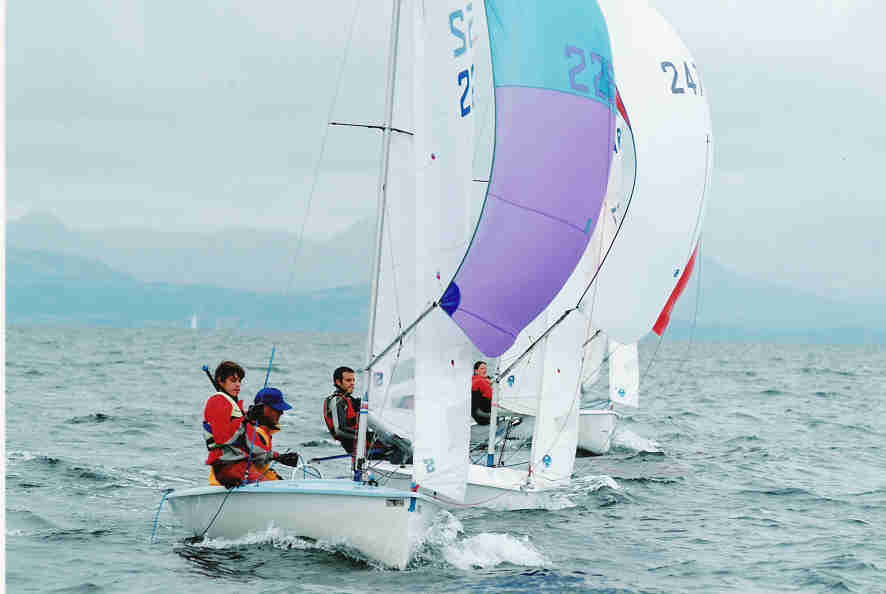











Boats for sale
| Rossiter Pintail Mortagne sur Gironde, near Bordeaux |
 |
| Laser 28 - Excellent example of this great design Hamble le rice |
 |
| Laser 140101 Tynemouth |
 |
List classes of boat for sale |
Mark Rounding II |
Post Reply 
|
| Author | |
john.d.knight 
Groupie 
Joined: 09 Jul 04 Location: United Kingdom Online Status: Offline Posts: 42 |
 Post Options Post Options
 Quote Quote  Reply Reply
 Topic: Mark Rounding II Topic: Mark Rounding IIPosted: 11 Jan 06 at 1:38pm |
|
http://www.finckh.org/rspiel/regeln/cases/case15.htm shows that the inside boat can carry on sailing when going up wind but if they were going down wind an inside boat is obliged to gybe on to the new course ASAP. Can someone explain why?
|
|
|
Pain is just weakness leaving the body.
|
|
 |
|
Stefan Lloyd 
Really should get out more 
Joined: 03 Aug 04 Online Status: Offline Posts: 1599 |
 Post Options Post Options
 Quote Quote  Reply Reply
 Posted: 11 Jan 06 at 2:56pm Posted: 11 Jan 06 at 2:56pm |
|
RRS 18.4b says an inside boat must gybe promptly if required to sail her proper course. It is different downwind because 18.4b says "gybe" but it does not say "tack". If you are asking why the RRS were written that way, I have no idea.
|
|
 |
|
Garry 
Really should get out more 

Joined: 18 Apr 04 Location: United Kingdom Online Status: Offline Posts: 536 |
 Post Options Post Options
 Quote Quote  Reply Reply
 Posted: 11 Jan 06 at 9:03pm Posted: 11 Jan 06 at 9:03pm |
|
I'm making this up as I can't be bothered to get the rule book so could be totally wrong. At least one key statement in this case is there is no overlap. Therefore there is no obligation on the inside boat to sail her proper course.
The boat to leeward could luff but as a boat tacking has to keep clear of a boat on a tack, she can't go beyond head to wind (and must give A theopportunity to keep clear). A boat that by her own actions becomes a give way boat can't claim the time to respond at the point she must keep clear. Tactically, you would only sail on if you wanted to sail B down the fleet. B can respond by luffing to head to wind in the hope it will force A to tack. Slowing down, tacking and dipping A's stern only leaves you in her dirty wind if A then tacked. When going downwind a boat clear astern on the opposite gybe would be able to sail behind if the inside boat just sailed on or gybe behind if on the same tack. |
|
|
Garry
Lark 2252, Contender 298 www.cuckoos.eclipse.co.uk |
|
 |
|
Post Reply 
|
| Forum Jump | Forum Permissions  You cannot post new topics in this forum You cannot reply to topics in this forum You cannot delete your posts in this forum You cannot edit your posts in this forum You cannot create polls in this forum You cannot vote in polls in this forum |
Bulletin Board Software by Web Wiz Forums® version 9.665y
Copyright ©2001-2010 Web Wiz
Change your personal settings, or read our privacy policy
Copyright ©2001-2010 Web Wiz
Change your personal settings, or read our privacy policy











 Printable Version
Printable Version Delicious
Delicious Digg
Digg Facebook
Facebook Furl
Furl Google
Google MySpace
MySpace Newsvine
Newsvine reddit
reddit StumbleUpon
StumbleUpon Twitter
Twitter Windows Live
Windows Live Yahoo Bookmarks
Yahoo Bookmarks Topic Options
Topic Options